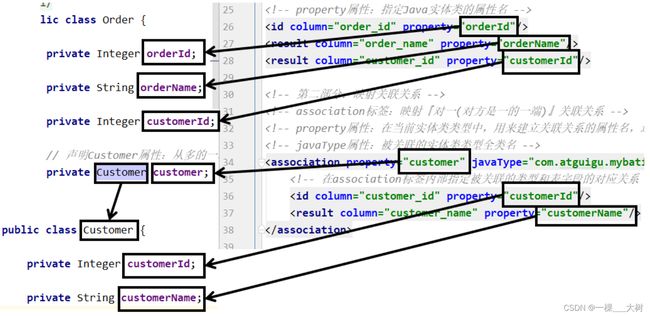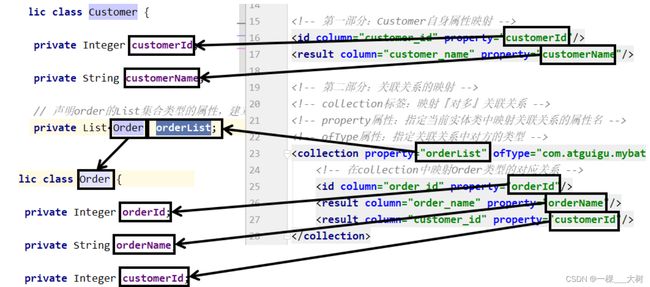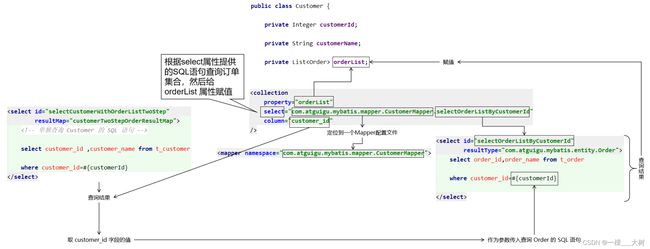【Mybatis】3—Mybatis映射关联关系
⭐⭐⭐⭐⭐⭐
Github主页https://github.com/A-BigTree
笔记链接https://github.com/A-BigTree/Code_Learning
⭐⭐⭐⭐⭐⭐
如果可以,麻烦各位看官顺手点个star~
如果文章对你有所帮助,可以点赞收藏⭐支持一下博主~
文章目录
- 4 使用Mybatis映射关联关系
-
- 4.1 概念
-
- 4.1.1 关联关系概念
-
- 数量关系
- 关联方向
- 4.1.2 创建模型
-
- 创建实体类
- 数据库测试数据
- 4.2 对一关系
-
- 4.2.1 OrderMapper配置文件
- 4.2.2 关键词
- 4.3 对多关系
-
- 4.3.1 CustomerMapper配置文件
- 4.3.2 关键词
- 4.4 分布查询
-
- 4.4.1 概念和需求
- 4.4.2 具体操作
-
- 编写查询Cutomer的SQL语句
- 编写Order的SQL语句
- 引用SQL语句
- 各要素之间的关系
- 4.5 延迟加载
-
- 4.5.1 概念
- 4.5.2 配置
-
- 较低版本
- 较高版本
- 4.5.3 关键词总结
4 使用Mybatis映射关联关系
4.1 概念
4.1.1 关联关系概念
数量关系
主要体现在数据库表中
-
一对一
夫妻关系,人和身份证号
-
一对多
用户和用户的订单,锁和钥匙
-
多对多
老师和学生,部门和员工
关联方向
主要体现在Java实体类中
- 双向:双方都可以访问到对方
- Customer:包含Order的集合属性
- Order:包含单个Customer的属性
- 单向:双方中只有一方能够访问到对方
- Customer:不包含Order的集合属性,访问不到Order
- Order:包含单个Customer的属性
4.1.2 创建模型
创建实体类
public class Customer {
private Integer customerId;
private String customerName;
private List<Order> orderList;// 体现的是对多的关系
}
public class Order {
private Integer orderId;
private String orderName;
private Customer customer;// 体现的是对一的关系
}
数据库测试数据
CREATE TABLE `t_customer` (`customer_id` INT NOT NULL AUTO_INCREMENT, `customer_name` CHAR(100), PRIMARY KEY (`customer_id`) );
CREATE TABLE `t_order` ( `order_id` INT NOT NULL AUTO_INCREMENT, `order_name` CHAR(100), `customer_id` INT, PRIMARY KEY (`order_id`) );
INSERT INTO `t_customer` (`customer_name`) VALUES ('c01');
INSERT INTO `t_order` (`order_name`, `customer_id`) VALUES ('o1', '1');
INSERT INTO `t_order` (`order_name`, `customer_id`) VALUES ('o2', '1');
INSERT INTO `t_order` (`order_name`, `customer_id`) VALUES ('o3', '1');
实际开发时,一般在开发过程中,不给数据库表设置外键约束。 原因是避免调试不方便。 一般是功能开发完成,再加外键约束检查是否有bug。
4.2 对一关系
4.2.1 OrderMapper配置文件
<resultMap id="selectOrderWithCustomerResultMap" type="com.atguigu.mybatis.entity.Order">
<id column="order_id" property="orderId"/>
<result column="order_name" property="orderName"/>
<association property="customer" javaType="com.atguigu.mybatis.entity.Customer">
<id column="customer_id" property="customerId"/>
<result column="customer_name" property="customerName"/>
association>
resultMap>
<select id="selectOrderWithCustomer" resultMap="selectOrderWithCustomerResultMap">
SELECT order_id,order_name,c.customer_id,customer_name
FROM t_order o
LEFT JOIN t_customer c
ON o.customer_id=c.customer_id
WHERE o.order_id=#{orderId}
select>
对应关系参考下图:
4.2.2 关键词
在“对一”关联关系中,我们的配置比较多,但是关键词就只有:association和javaType。
4.3 对多关系
4.3.1 CustomerMapper配置文件
<resultMap id="selectCustomerWithOrderListResultMap"
type="com.atguigu.mybatis.entity.Customer">
<id column="customer_id" property="customerId"/>
<result column="customer_name" property="customerName"/>
<collection property="orderList" ofType="com.atguigu.mybatis.entity.Order">
<id column="order_id" property="orderId"/>
<result column="order_name" property="orderName"/>
collection>
resultMap>
<select id="selectCustomerWithOrderList" resultMap="selectCustomerWithOrderListResultMap">
SELECT c.customer_id,c.customer_name,o.order_id,o.order_name
FROM t_customer c
LEFT JOIN t_order o
ON c.customer_id=o.customer_id
WHERE c.customer_id=#{customerId}
select>
对应关系可以参考下图:
4.3.2 关键词
在“对多”关联关系中,同样有很多配置,但是提炼出来最关键的就是:collection和ofType。
4.4 分布查询
4.4.1 概念和需求
为了实现延迟加载,对Customer和Order的查询必须分开,分成两步来做,才能够实现。为此,我们需要单独查询Order,也就是需要在Mapper配置文件中,单独编写查询Order集合数据的SQL语句。
4.4.2 具体操作
编写查询Cutomer的SQL语句
<select id="selectCustomerWithOrderList" resultMap="selectCustomerWithOrderListResultMap">
select customer_id,customer_name from t_customer
where customer_id=#{customerId}
select>
编写Order的SQL语句
<select id="selectOrderList" resultType="com.atguigu.mybatis.entity.Order">
select order_id,order_name from t_order where customer_id=#{customer_id}
select>
引用SQL语句
<resultMap id="selectCustomerWithOrderListResultMap"
type="com.atguigu.mybatis.entity.Customer">
<id column="customer_id" property="customerId"/>
<result column="customer_name" property="customerName"/>
<collection
property="orderList"
select="com.atguigu.mybatis.mapper.CustomerMapper.selectOrderList"
column="customer_id"/>
resultMap>
各要素之间的关系
4.5 延迟加载
4.5.1 概念
查询到Customer的时候,不一定会使用Order的List集合数据。如果Order的集合数据始终没有使用,那么这部分数据占用的内存就浪费了。对此,我们希望不一定会被用到的数据,能够在需要使用的时候再去查询。
例如:对Customer进行1000次查询中,其中只有15次会用到Order的集合数据,那么就在需要使用时才去查询能够大幅度节约内存空间。
延迟加载的概念:对于实体类关联的属性到需要使用时才查询。也叫懒加载。
4.5.2 配置
较低版本
<settings>
<setting name="lazyLoadingEnabled" value="true"/>
<setting name="aggressiveLazyLoading" value="false"/>
settings>
较高版本
<settings>
<setting name="lazyLoadingEnabled" value="true"/>
settings>
效果:刚开始先查询Customer本身,需要用到OrderList的时候才发送SQL语句去查询
4.5.3 关键词总结
我们是在“对多”关系中举例说明延迟加载的,在“对一”中配置方式基本一样。
| 关联关系 | 配置项关键词 | 所在配置文件和具体位置 |
|---|---|---|
| 对一 | association标签/javaType属性 | Mapper配置文件中的resultMap标签内 |
| 对多 | collection标签/ofType属性 | Mapper配置文件中的resultMap标签内 |
| 对一分步 | association标签/select属性/column属性 | Mapper配置文件中的resultMap标签内 |
| 对多分步 | collection标签/select属性/column属性 | Mapper配置文件中的resultMap标签内 |
| 延迟加载3.4.1版本前 | lazyLoadingEnabled设置为true aggressiveLazyLoading设置为false |
Mybatis全局配置文件中的settings标签内 |
| 延迟加载3.4.1版本后 | lazyLoadingEnabled设置为true | Mybatis全局配置文件中的settings标签内 |


